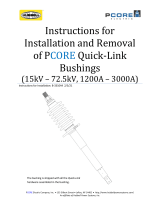
i
ELECTRIC COOKERS 8SMS, 8BC AND 8C
TABLE OF CONTENTS
CHAPTER 1: General Information
1.1 Parts Ordering and Service Information..........................................................................1-1
1.2 Safety Information...........................................................................................................1-1
1.3 Equipment Description ....................................................................................................1-2
1.4 Installation, Operating, and Service Personnel................................................................1-2
1.5 Definitions........................................................................................................................1-3
1.6 Shipping Damage Claim Procedure................................................................................. 1-3
CHAPTER 2: Installation Instructions
2.1 General Installation Requirements................................................................................... 2-1
2.2 Caster/Leg Installation.....................................................................................................2-2
2.3 Pre-Connection Preparations ...........................................................................................2-2
2.4 Connecting to the Electrical Power Supply.....................................................................2-3
Field Connection Wiring Diagrams.................................................................................2-4
CHAPTER 3: Operating Instructions
3.1 Introduction......................................................................................................................3-1
3.2 Operating Instructions......................................................................................................3-2
3.3 Shutting the Cooker Down...............................................................................................3-2
3.4 Boiling Out the Cookpot..................................................................................................3-3
CHAPTER 4: Preventive Maintenance
4.1 Daily Preventive Maintenance.........................................................................................4-1
4.2 SMS II Controller Simmer Mode Adjustment.................................................................4-2
CHAPTER 5: Operator Troubleshooting
5.1 Introduction......................................................................................................................5-1
5.2 Operator Troubleshooting Guides....................................................................................5-2
5.3 Replacing the Controller or Controller Wiring Harness..................................................5-3
5.4 Replacing Fuses...............................................................................................................5-4
CHAPTER 6: Service Procedures
6.1 Functional Description of Electric Cookers 8SMS, 8BC, and 8C...................................6-1
6.2 Accessing Equipment for Servicing.................................................................................6-2
6.3 Replacing Equipment Components..................................................................................6-2
6.3.1 Replacing the Controller..................................................................................................6-2
6.3.2 Replacing the Transformer, Basket Lift Relay, Contactor, or Solenoid Valve ...............6-2
6.3.3 Replacing the Element.....................................................................................................6-3
6.3.4 Replacing the High-Limit Thermostat............................................................................. 6-4
6.3.5 Replacing a Water Level Sensor or the Temperature Probe............................................6-5
6.3.6 Replacing the Pressure Regulator....................................................................................6-6
6.3.7 Replacing the Water Faucet.............................................................................................6-7
6.3.8 Replacing the Cookpot or Rinse Tank.............................................................................6-8
6.3.9 Replacing the Basket Lift Motor and Related Components ..........................................6-10

























